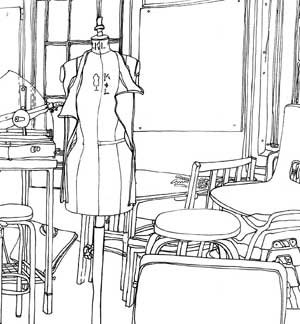
| HOME |
| NERVE |
| REVIEWS |
| ARCHIVE |
| EVENTS |
| LINKS |
| ABOUT US |
| CONTRIBUTORS |
| BACK ISSUES |
| CONTACT US |
 Jane
Hughes: Lines of Perception
Jane
Hughes: Lines of Perception
Unity Theatre, Hope Place (31st March – 2nd May 2009)
Reviewed by Sandra Gibson
This intimate exhibition successfully combines drawing and writing; the figurative and the non-figurative.
The set of drawings in the top floor room forms a discreet group of confidently vigorous studies of a group of dancers. One feels the combination of movement and figurative solidity here – linear decisiveness and a sense of formal composition.
By contrast, the other ink drawings are two-dimensional: studies of interior work activities, those at work being part of the linear response to the paraphernalia of workshop and studio rather than being the main subject. Indeed, the figures do not meet the artist’s gaze; even the guitarist is drawn from behind. All are totally absorbed in their work: concentrating at an easel, goggled, using a band saw, kneeling to make a stretcher. The artist addresses the subject of creative process and product and at one level these drawings are an equivalent of industrial photographs – the pattern block cupboard, the caretaker’s room, the transfer press room, the mass-produced chairs cutting as much a dash as anything or anyone else. Figurative content has been minimised – eliminated in many of the drawings – perhaps to stress the point.
So what of the writing? This takes the form of an immediate response to environmental stimuli as perceived by the artist, written on objets trouves (‘found objects’)– a cupboard door in one case. Carefully noting the start and finish times, the artist records the strident, obtrusive urgency of other peoples’ lives: their conversation, eating, drinking - discussing projects, being upset; the sounds and sights and textures of what is happening around and off, mechanical diggers outside: other lives, other work. This writing is what any artist is about – being aware, having a sensory and emotional awareness beyond the merely visual and beyond the job in hand. It contains what has been eliminated from the drawings and this is why the writing complements the drawing.
I recommend this exhibition for its intelligence and the technical expertise of its draughtsmanship; its elegance and linear complexity.